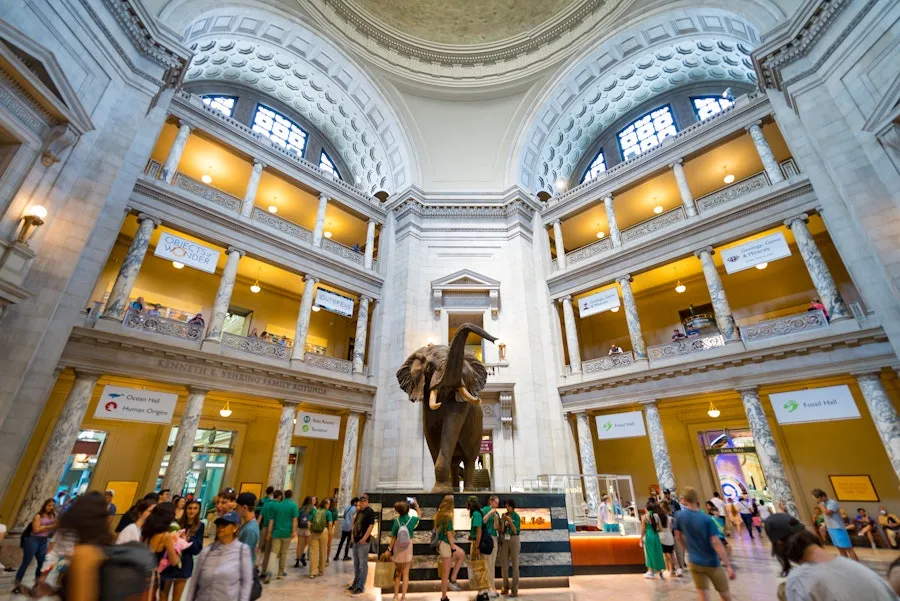Washington D.C., the capital of the United States, is not only a political center but also a treasure trove of culture and science, where visitors can explore the wonders of the natural and man-made world. With world-class museums, D.C. offers rich educational and entertaining experiences for all ages. Let’s explore the top science museums that you shouldn’t miss when visiting this city.
Smithsonian National Museum of Natural History
The Smithsonian National Museum of Natural History, opened in 1910, is one of the most attractive destinations in Washington D.C. With its distinctive green dome architecture and vast scale equivalent to 18 football fields, this museum houses more than 140 million natural science specimens and cultural artifacts. It is not just a museum, but also a center for discovery and education about the natural world.

Location and How to Get There
The National Museum of Natural History is centrally located in Washington D.C., on the National Mall. Like all Smithsonian museums, admission is free. Regular opening hours are from 10:00 AM to 5:30 PM, but during spring and summer, opening hours are extended to 7:30 PM. The museum is open every day of the year, except December 25th.
The most convenient way to get to the museum is by public transportation. Public parking is very limited, but parking is available for visitors with disabilities. If using Metrorail, you can take the Orange or Blue lines to the Smithsonian station and use the National Mall exit. If taking Metrobus, routes 32, 34, or 36 will take you to the museum.
Exploring Inside the Museum
The Smithsonian National Museum of Natural History contains many world-famous artifacts. The Janet Annenberg Hooker Hall of Geology, Gems, and Minerals displays the famous Hope Diamond, believed to be cursed. The Q?rius education center provides teenagers with a laboratory where they can make their own scientific discoveries.

After seven years of renovation, the museum has reopened the David H. Koch Hall of Fossils – Deep Time. This 31,000-square-foot exhibit is themed “Deep Time,” a scientific phrase illustrating Earth’s history spanning billions of years. This exhibition promises to bring incredible and engaging experiences to visitors.
Other permanent exhibits include an insect zoo and the Sant Ocean Hall, which displays an exact replica of a North Atlantic right whale.
Other Science Museums in Washington D.C.
In addition to the National Museum of Natural History, Washington D.C. has many other science museums worth exploring:
- Smithsonian National Air and Space Museum: One of the world’s largest aviation and space museums, displaying spacecraft, rockets, and artifacts related to the history of space exploration.
- Marian Koshland Science Museum of the National Academy of Sciences: This center focuses on science in everyday life, with interactive exhibits that help visitors better understand important scientific issues.
- National Museum of Health and Medicine: Showcasing the history of medicine, from ancient healing methods to modern scientific advances.
- National Children’s Museum: Designed for children, this museum encourages learning through play and exploration.
Tips for a Fun Museum Visit
To have a fulfilling visit to the science museums in Washington D.C., keep these tips in mind:
- Plan ahead: Identify the museums you want to visit and find out about special exhibits or events taking place.
- Arrive early: Museums are often crowded, especially on weekends and holidays. Arriving early will help you avoid crowds and have more time to explore.
- Use public transportation: Parking in the city center can be difficult and expensive. Using Metrorail or Metrobus is a more convenient and economical option.
- Bring water and snacks: You may spend hours exploring a museum, so prepare water and snacks to keep your energy up.
- Join guided tours: Guided tours will provide you with detailed information and interesting stories about artifacts and exhibits.
- Don’t hesitate to ask questions: Museum staff are always willing to answer your questions and provide more information.
Conclusion
Washington D.C. is an ideal destination for those who love science and want to explore the world around them. With top-notch science museums, this city offers unforgettable educational and entertaining experiences. From the Smithsonian National Museum of Natural History to the National Air and Space Museum, each museum has its own stories to tell and wonders to discover. Plan your trip today and start your science exploration journey in Washington D.C.!